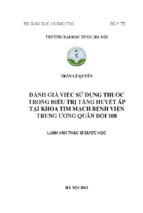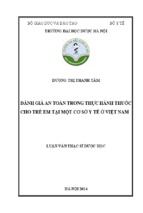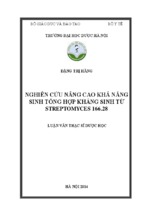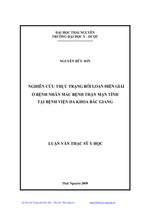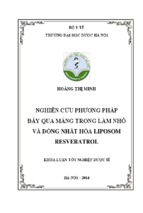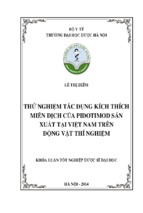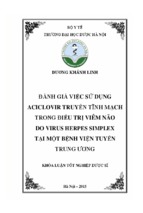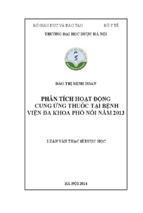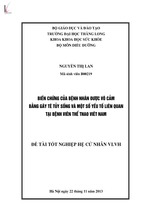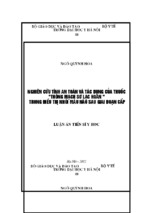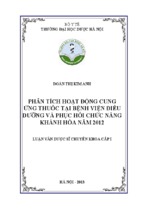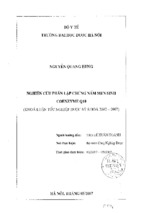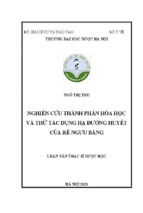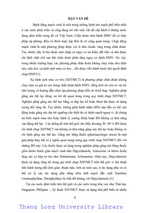CORPORATE SOCIAL RESPONSIBILITY IN VIETNAM; A
STUDY OF ITS IMPORTANCE
BY
PHAM THUY LY
E0700048
i
BACHELOR OF BUSINESS (ACCOUNTING) HONS
HELP UNIVERSITY COLLEGE
MARCH 2011
DECLARATION OF ORIGINALITY
AND WORD COUNT
I hereby declare that the graduation project is based on my original work except for
quotations and citations which have been duly acknowledged. I also declare that it has not
been previously or concurrently submitted for any other course/degree at Help University
College or other institutions. The word count is 10,758 words.
ii
_____________________
Pham Thuy Ly
28 March, 2011
ACKNOWLEDGEMENT
This project would not have been made possible without the assistance, support and
encouragement of many people. I wish to take this opportunity to thank all the people who
have helped me during the time of completing this study.
I would like to express my deep gratitude to my supervisor Dr. Le Van Lien, International
School, Vietnam National University Hanoi. He has kindly helped me and supported me all
the way through. I also would like to express my thank to Ms. Sumathi and Ms. Shenba, Help
University College, who initiated the project and give so much instruction and support.
Additionally, I also would like to extend my special thanks to managers, accountants, my
friends, and other people who have help me to carry out the survey. I want to thank them for
all their support, interest and valuable hints.
PHAM THUY LY
iii
CORPORATE SOCIAL RESPONSIBILITY IN VIETNAM; A
STUDY OF ITS IMPORTANCE
By
PHAM THUY LY
March 2011
Supervisor: Dr. Le Van Lien
ABSTRACT
CSR is currently an important and necessary issue for everyone and business organizations in
the world, as well as in Viet Nam. CSR concept has been developed for several decades in
the world, but in Viet Nam, it is not popular for all people and companies. Especially,
Vietnamese economy has been integrated with global economy, and then CSR has become
more important issues for business to develop sustainably and competition with internal and
external partners. In order to develop CSR concept and disclosure further, perception on CSR
of stakeholder groups is a unique factor. This study aims to discover how organization view
CSR and CSR issues, whether behavior or attitude of manager‟s business organization and
consumers, as well as accounting students toward CSR. The results of the study suggest that
there is strong support for CSR from managers and a growing awareness among consumers
and accounting students. Nevertheless, there is expectation gap between how people perceive
and how people act because there are lack of adequate CSR disclosure from firm, and not-soiv
enthusiastic support actions from consumers due to the barriers in living expenses, and low
effective CSR communication tools that companies use. However, with highly positive
attitude toward CSR and the willingness to learn about CSR of people, CSR concept and
practice will be popular and developed further in the future.
TABLE OF CONTENTS
DECLARATION OF ORIGINALITY AND WORD COUNT
i
ACKNOWLEDGEMENT
ii
ABSTRACT
iii
TABLE OF CONTENTS
iv
LIST OF FIGURES
v
1.
INTRODUCTION
1
1.1
Idea for Corporation Social Responsibility
1
1.2
CSR in the world
2
1.3
CSR in Vietnam
3
1.4
The reason for conduct this research
4
2.
LITERATURE REVIEW
5
2.1
5
The definition and conceptualization of CSR
2.1.1 Zenisek‟s conceptualization (1979)
6
2.1.2 Carroll‟s conceptualization (1979)
6
2.1.3 Wood 1991 conceptualization
9
2.2
Stakeholder theory
11
2.3
Social accounting
13
v
3.
4.
2.4
CSR reporting
15
2.5
Hypothesis
17
2.5.1 Manager‟s perception on CSR conceptualization
17
2.5.2 Consumer‟s perception on CSR conceptualization
18
2.5.3 Accounting student‟s perception on CSR conceptualization
20
RESEARCH METHODOLOGY
22
3.1
Research objective
22
3.2
Applied research methodology
22
3.3
Data source
22
3.3.1 Primary data source
23
3.3.2 Secondary data
23
3.4
Research method
24
3.5
Research tool
24
3.6
Data collection
25
3.7
Sampling
25
3.7.1 Sample population
25
3.7.2 Sample entity
25
3.7.3 Sample size
26
3.8
26
Language in questionnaire
FINDINGS AND ANALYSIS
27
vi
4.1
Findings
27
4.2
Result analysis
28
4.2.1 Management
28
4.2.1.1 Result of manager‟s questionnaire survey
28
4.2.1.2 Discussion
30
4.2.1.3 Conclusion
31
4.2.2 Consumers
32
4.2.2.1 Result of questionnaire survey
32
4.2.2.2 Discussion
34
4.2.2.3 Conclusion
36
4.2.3 Accounting students
4.3
5.
36
4.2.3.1 Result of questionnaire survey
36
4.2.3.2 Discussion
38
4.2.3.3 Conclusion
39
Implementation
39
CONCLUSION
40
5.1
Conclusion
40
5.2
Recommendation
42
5.3
Limitation of study
43
REFERENCES
45
vii
APPENDIX: QUESTIONNAIRE
56
LIST OF FIGURES
Figure 2.1. A hierarchy of CSR (adapted from Carroll, 1991) ....................................................... 8
Figure 2.2. The CSP Model (adapted from Wood, 1991) ............................................................. 11
Figure 4.1. Respondents ................................................................................................................ 27
Figure 4.2. Distribution of responses from management survey .................................................. 28
Figure 4.3. Distribution of responses from consumer survey ....................................................... 32
Figure 4.4. Distribution of responses from accounting student survey ........................................ 36
viii
CHAPTER I: INTRODUCTION
1.1.
Idea for Corporate Social Responsibility
In recent time, CSR concept is not new to people in over the world. CSR is concerned by not
only enterprises, but also relevant parties, and stakeholders (“stakeholder” is the people are
directly affected by the business operation). In the past, most of firms only concern for profit
maximize wherever their factories caused some negative effects on environment and local
citizen around their location. However, this attitude has been changeable, as most of firms
need to care about their responsibilities toward society. This is also the foundation for
appearance the concept of “CSR” that is the way business balance between their operations
and their effect on environment and society. In other words, managers also take strategies to
meet the expectations of shareholders and stakeholders relating to their attitude toward
society. The key word of this concept is “Social Responsibility” including organization‟s
interaction with environment and organization‟s treatments for employees also. Based on
concentration on CSR, managers expect that they will involve their firms into sustainable
developments. For more clear understanding about the concept of CSR, the following parts
will provide more detailed information about CSR in the world, the fact of CSR in Vietnam,
and the reason for conduct this research.
1
1.2.
CSR in the world
As mentioned above, most firms focus on CSR strategies in their operations. Besides
financial reports, they also concern about CSR report. CSR report or we call Sustainability
report is the strategic tool help managers evaluate what they done to meet stakeholder‟s
expectations, and what they need to improve better stakeholder‟s expectations. Sustainability
reports are not new and this type of report is published by over two-thirds of the Fortune
Global 500 companies. Sustainability reports also help manager evaluate the economic and
social performance (http://www.environmentalleader.com). We know some reputation
corporation that issued its CSR reports every year such as: Philips Electronics, Facility
Service Company ABM, Coca-Cola, Dell, and Hitachi… Most of firms tried to conduct some
strategic methods to improve the quality of its CSR report every year. We just look at some
examples including: Philips Electronics, Toshiba Groups. Philips Electronics always focus on
in its carbon footprint. Between 2009 and 2010, this corporation also reduced this element by
seven percent, and increased operational energy efficiency by six percent. In addition, green
innovation has been invested of 450 million for the purpose of improve CSR toward society
(www.environmentalleader).Another example comes from Toshiba Group. This group has
issued CSR Report 2010 in which Toshiba Group strives to act with the highest level to
protect environment and solves the social issues facing by this corporation
(http://www.toshiba.co.jp). Besides that, Toshiba focus on the third party commends on the
CSR 2010, as well as getting CSR Report back issues. Doing that, Toshiba Group‟s managers
can learn from the existing issues and improve their responsibility toward the society. There
are two of many examples relating to corporations that focus on CSR and pursue sustainable
development.
2
1.3.
CSR in Vietnam
The word “CSR” was appeared in Vietnam for long time; nevertheless Vietnamese citizen
and Vietnamese‟s enterprises do not understand it completely. More detail, through twenty
six (26) Vietnamese Accounting Standards, we have no any Vietnamese Accounting Standard
mentions the necessity of conducting CSR Report or Social accounting; whereas most of the
international firms involve the social accounting system in its report system. However, in
recent year, Vietnamese government has taken some significant steps to raise the awareness
of business men. Vietnamese government also set up some forum about CSR to educate most
business should act in stakeholder‟s perspective. This is shown that Vietnam is trying to
make CSR as an important factor in sustainable development. Not only Vietnamese
corporations, but also international corporations in Vietnam have to care about their
stakeholders when they conduct their business operations. Besides that, Vietnam set up the
CSR awards in order to improve organizations operating in Vietnam territory to improve their
responsibilities toward society. Vietnamese government made some detail plan and strategy
and projects concerned in CSR based on its resources such as working conditions, safety,
hygiene, environment, quality and productivity, labor relations and manpower resources
management (http://www.bpsc.com.vn). Nevertheless, we face some interferences and
challenges in developing CSR in Vietnam, such as: the concept of CSR is not still updated to
most of the Vietnamese businessmen circles. The concerned sides do not identify long term
plan and strategy to conduct the programs of CSR in practice. On the other hands, this is lack
of companies‟ management ability and professional knowledge in concept of CSR.The topic
of CSR becomes the burn topic when we found that pollution for Thi Vai River from Vedan
Vietnam Corp. This river is polluted seriously by untreated wastewater, and this caused the
bad effects on the local people (http://english.thesaigontimes.vn).Another aspect of CSR
violation in Vietnam is issue relating to labor standards. Most of Vietnam‟s labor are paid
3
with the low cost and treated unfair by both of private domestic and foreign-invested
enterprises. According to Ho Chi Minh City LA our officials, Vietnamese labors are dealing
with the serious violations of the Vietnamese Labor Law that increasing continuously.
Besides that, one report on May 26 showed that thirty four domestic and foreign-invested
limited companies revealed numerous violations related to labor contracts, payment policies,
overtime hours, annual leave, and pregnancy and sick leave (http://www.csr-asia.com).These
examples again dedicate that it is the time for Vietnam government and Vietnamese relevant
parties need to improve completely knowledge about CSR, as well as define some solution
for CSR violations happening in Vietnam, contribute to strategy for sustainable development.
1.4.
The reason for conduct this research
As we know, after “Doi moi” policy in Vietnam in 1986, Vietnam developed rapidly.
Moreover, Vietnam has joined World Trade Organization (WTO) shows evidence for
Vietnam need to pursue strategies for sustainable developments in long term. The research is
conducted with purpose of improvement CSR knowledge for managers, consumers, and
accounting students. Managers need to know clearly the overall picture of CSR to act in the
effective way, whereas stakeholders need to know how the CSR support for their life from
the bad effect of business operations. More importance, accounting students, they need to
aware about the concept in CSR as they will be the future general develop country better.
4
CHAPTER 2: LITERATURE REVIEW
2.1The definition and conceptualization of CSR
For past few decades, an examination of literature on CSR continues to be an interesting issue
for researchers and academics. Over the last three decades, many academics and economic
consultants have debated finding the definition of social responsibility of doing business.
Two decades ago, Neli Chamberlain( 1953) defined social responsibility in terms of action
that the leadership in business and unions are expected to take with the respect to their
following in a given situation as mater of right, whether legal or non-legal. Against the
feature of Chamberlain‟s definition, William Frederick (1960) expressed that social
responsibility is not simply to narrow benefit and interest of individual persons or companies
that is to combine of human and economic resources for social benefits. Philip Klein (1978)
explains the meaning of social responsibility as relating to internal and external
organizational problems. In which, internal problems are stockholders and labors rights while
external problems are responsibilities dealing with the affect of the products or services on
the community, the relationship among firm and society.
The above discussion of different authors leads to one conclusion that any definition of
phenomenon of corporate social responsibility must involve the relationship between social
ideology and business ethic in both ideological and operational aspects. (Zenisek J,1986).
Nevertheless, the developing definition of CSR is complex process because it could
understand different meaning to different stakeholder groups. For example, shareholders
could define CSR is maximization of profits or high earnings. To customer CSR may mean
high quality product or services at a good price and perhaps ethical behavior.
5
In this paper, there are three studies which are introduced including Zenisek (1979); Carroll
(1979) and Wood (1991).
2.1.1 Zenisek’s conceptualization (1979)
In 1979, Zenisek (University of Calgary) proposed that corporate social responsibility is
conceptualized as the degree of “fit” between society‟s expectations of the business
community and the ethics of business. There are two components in this “fit” which are
behavioral and attitudinal. The first component is the fit between social expectations and
firm‟s actions. Thus, the first component of social responsibility is what a business does in
relation to what society expect to do.
The second component is attitudinal which is fit between social expectations and what a
business manager‟s regard to be legitimate societal demands. This component represents
ideological aspect of the firm‟s ethics.
2.1.2
Carroll's CSR model (1979)
Carroll‟s model in 1979 perhaps the most oft-cited definition of corporate social
responsibility. Carroll‟s CSR model contains four categories of corporate responsibility
arranged from most to least important including economic, legal, ethical and philanthropic.
Firstly, according to Carroll‟s model, all business responsibilities are based on the
corporation‟s economic responsibility. It indicates that business organization‟s principal role
provides product or services what customer‟s need and want and making acceptable profits in
the process. In other words, before business organization was anything else, it was the basic
6
economic in the community. The motivation of profit was considered as the primary
motivator for companies.
Secondly, legal responsibility is principal expectation of society to business that include
implying with laws and regulations issued by federal, state and local governments as ground
rules which business must operate. Besides that, business and society firms are expected to
pursue their economic missions within the legal framework of the law as a partial fulfillment
of the social contract. In other concept, legal responsibility reflects a view of “codified
ethics” that embody basic notion of fair operation.
Third part, ethical responsibilities combine those standards, norms, or expectations that
reflect a concern, for what consumers, employees, shareholders, and the community regard as
fair, just, or in keeping with the respect or protection of stakeholders' moral rights. In another
sense, ethical responsibilities may be seen as newly emerging values and norms society
expects business to meet, even though higher standard of performance of such values and
norms. Besides that, ethic responsibility is important to perform in a manner consistent with
expectations of societal mores and ethical norms or to recognize and respect new or evolving
ethical moral norms adopted by society.
Finally, philanthropic responsibilities encompass those corporate actions in respond to
society‟s expectation to make companies to be good corporate citizens. For example, those
activities are business contribution of finance resources or executive time to art, education or
the community. The different feature between philanthropic and ethical responsibilities is that
society‟s expectation is based on ethical or moral sense. In other word, communities expect
companies to provide their money, facilities, and employee time to humanitarian programs.
However, firms are regarded as ethical if it does not satisfy the desired level. Therefore, on
7
the part of business, philanthropy responsibility is more discretionary or voluntary even
through businesses always provide societal expectation.
Figure2.1: Carroll (1991) CSR Pyramid
There is no research or study to be exact and conceptualization CSR model of Carroll is the
same situation. Carroll‟s conceptualization is either a durable or useful model for defining
and exploring CSR. However, this model has some lacking of conceptual clarity and
questions about its descriptive accuracy, especially in different cultural contexts. Secondly, it
is very simplistic and static, failing to capture the complexity of CSR in practice. Besides
that, definition of CSR/CSP in this model domains but not the nature of responsibility or
performance (Wood, 1991).
8
2.1.3
Wood 1991 conceptualization
Wood (1991) took similar approach concepts of corporate by proposing a conceptual model
social responsibility. Corporate social performance or CSR is defined more completely than
Carroll‟s once as: “a business organization’s configuration of principles of social
responsibility processes of social responsiveness, and policies, programs and observable
outcomes as they related to the firm’s societal relationships” (Wood, 1991).
Wood (1991) argued that business and society are interwoven rather than distinct separate
entities. Hence, society has certain expectations of business behavior and outcomes with
regard to business. These expectations can be divided into three groups with corresponding
principles (figure 2.2). The first group includes expectations of all businesses because their
roles play as economic institutions. The principle that applies to institutional level of analysis
is that of legitimacy. The principle of legitimacy is to concerns business as a social institution
and frames the analytical view of the inter-relationship of business and society. This principle
is based on the premise that “society gave business its charter to exist, and that charter could
be amended or revoked at any time that business fails to live up to society's expectations.”
(Davis & Blomstrom,1971).
The second group expectations are placed in individual firms. This principle is for
organizational level of analysis that the principle of public responsibility applies. According
to this principle, Wood (1991) states that businesses do not have responsibility to solve all
social issues but they are responsible for their stakeholders and to solve problems related to
their activities that they have caused and they are responsible for helping to solve problems
and social issues related to their business operations and interest.
The third group of expectations relates to the manager as a moral agent. It is for individual
level of analysis that is of managerial discretion. This principle is based on that “managers
9
exist in an organizational and societal environment that is full of choices, their actions are
not totally prescribed by corporate procedures, formal job definitions, resource
availabilities, or technologies. They are moral actors on the job as well as in other domains
of their lives” (Wood, 1991). This principle states that business‟s managers face ethical
concern when they make decisions. Basing on this principle, society expects managers to
focus both on the companies‟ interests and on the implications that their decisions have for
society.
In general, business organizations adopt their social responsibilities on above three levels that
will contribute to environmental improvement and sustainable development and will enjoy
consumer loyalty, as well as improving human resources management. These principles state
that responsibility of organizations is for “their primary and secondary areas of involvement
with society” and that managers are “moral actors obliged to exercise such discretion as is
available to them, toward socially responsible outcomes.” (Wood, 1991)
Furthermore, Wood (1991) also suggests that companies use three main of processes to apply
these principles into practice: environmental assessment, issues management, and stakeholder
management. In the process of CSP model, Wood presents the outcomes of bringing
principles into practice within the economic, legal, ethical, and discretionary domains,
categorizing them in terms of social impacts, social programs, and social policies.
In the contrast, there are some limitations of Wood principle of CSR. The first limitation
Wood (1991) acknowledged is that terms such as legitimate functions, obligations, and social
well-being are neither universal nor absolute in their meaning; they are time and culture
bound. It implies that a firm may have different responsibilities in different countries and at
different points in time. A second limitation is that these principles are defined variously by
relevant stakeholder groups even within a specific time and culture, concepts. As result, a
10
firm may face conflicting expectations. A third limitation is that organizational and
individual-level concepts including options, opportunities, constraints, and choices are bound
by different conditions and perceptions among organizations and people. Due to these
limitations, Wood (1991) concludes that “the principles of CSR should not be thought of
absolute standards, but as analytical forms to be filled with the content of explicit value
preferences that exist within a given cultural or organizational context and that are
operational zed through the political and symbolic processes of that context”.
Figure 1.2 Corporate Social Performance Model (Wood, 1991)
Principals of corporate social responsibility
Institutional principal: legitimacy
Organizational principal: public responsibility
Individual principal: managerial discretion
Processes of corporate social responsiveness
Environmental assessment
Stakeholder management
Issues management
Outcomes of corporate social behavior
Social policies
Social programs
Social impacts
2.2 Stakeholder theory
The term” stakeholder” is now popular word for most executives. The term implies various
stakeholder groups who can affect or be affect by the organization‟s activities. Freeeman
(1998) defines stakeholders as “groups and individuals who benefit from or are harmed by,
and whose rights are violated or respected by, corporate actions”. Stakeholders include
11
creditors, employees, customers, suppliers, and the communities at large. Hence,
stakeholder‟s legitimacy and power are influenced on the firm. For CSR perspective, their
legitimacy may be the most important. Hence, the concept of stakeholder personalizes social
and society responsibility should consider in CSR orientation (Carroll, 1991).
Deegan and Unerman (2006) states that “ more correctly, the tem stakeholder Theory as an
umbrella term that actually represents a number of alternative theories that address various
issues associated with relationship with stakeholders, including considerations of the rights
stakeholders the power of stakeholders or the effective management of stakeholders”
In other research, Jones and Wicks (1999) attempts to discuss the current state of stakeholder
theory which are summarized as following. First, the corporation has the relationships with
many stakeholder groups who can affect and can be affected by its decisions. Second, the
nature of these relationships in term of both processes and outcomes for the firm and its
stakeholders are main purpose of theory. Third, the interests of all stakeholders have intrinsic
value and no set of interests is assumed to dominate the others. Last, stakeholder theory
focuses on managerial decision making.
There are two branches of Stakeholder Theory namely ethical branch (moral) and the positive
(managerial) branch (Deegan 2009). Under the ethical perspective, business organization
must treat fairly all stakeholder groups by their right and business‟s managers should operate
organization for the benefit of all shareholders. Due to companies‟ moral obligations, hence,
they will expose information to their shareholders. In the contrast, the managerial perspective
of stakeholder theory attempt to distinguee that corporate disclosure is driven by the level of
power or control which are obligated by the specific stakeholder groups over the firm‟s
resources. And so, corporate management will attend to focus on expectations of particular
stakeholder groups (Freeman, 1984).
12
- Xem thêm -

